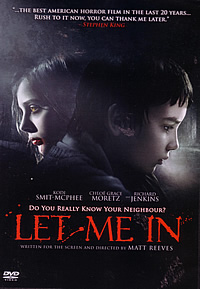SYNOPSIS:
Chloe
Moretz (Hit Girl from Kick-Ass) stars as Abby, a mysterious
12-year old girl, who moves next door to Owen (Kodi Smit-McPhee,
The Road). Owen is a social outcast who is viciously bullied
at school and in his loneliness, forms a profound bond with
his new neighbor. Owen can't help noticing that Abby is like
no one he has ever met before. As a string of grisly murders
occupy the town, Owen has to confront the reality that this
seemingly innocent girl is really a savage vampire.
MOVIE REVIEW:
Abby may just 12-year old female vampire compared to Twilight’s Edward Cullen, but don’t let that fool you into thinking that she has less bite. On the contrary, Abby is more formidable than any vampire in the entire Twilight franchise, so rest assured that “Let Me In” isn’t just another Twilight wannabe. Instead, it is a unique vampire movie that pretty much stands on its own- except perhaps for Tomas Alfredson’s Swedish original which itself is an adaptation of the John Ajvide Lindqvist novel.
Matt Reeves transports the story to a small New Mexico town called Los Alamos in the 1980s, but besides the change in location, his version is faithful to Alfredson’s film. Once again, the story is centred on the budding friendship between Abby and a similarly-aged boy Owen (Kodi Smit-McPhee) that begins when Abby moves into his next-door apartment one night with her guardian Renfro (Richard Jenkins).
The strength of Alfredson’s adaptation, as is also that of Reeves’ version, is in the tender and utterly convincing relationship that slowly develops between Abby and Owen. Their individual solitude is the basis of their bond- Owen a bully magnet at school without any friends and Abby the nocturnal creature keeping her distance from any human who could one day very well become her prey. Reeves creates an immediate intimacy between them, and draws you in effortlessly, so much so that you’ll find yourself enraptured by their deepening companionship.
But the attention Reeves pays to his characters also makes this a slow-boil, and he requests patience on the part of his viewer to allow the film to unfold at a deliberate pace. In turn, you’ll be rewarded by the vivid relationships that he develops between his characters- not just between Abby and Owen, but also between Abby and her guardian, and Owen and his recently separated parents. These relationships in particular bolster the central one between Abby and Owen, which takes an especially poignant turn towards the end of the film.
Reeves does an excellent job setting the mood of the film, muted yet tense every step of the way, aided in no small measure by Greig Fraser’s cinematography and Michael Giacchino’s gripping score. But much of the credit goes to the young stars of the film- Smit-McPhee and Abby’s Chloe Grace Moretz. McPhee follows up his turn as Viggo Mortensen’s son in “The Road” with another quiet but powerful performance, and Moretz’s cred continues to grow from strength to strength after equally impressive turns in “500 Days of Summer” and “Kick-Ass”.
And thanks to their uniformly outstanding performances, Reeves’ adaptation of “Let Me In” isn’t just a slavish remake of the original. While it does owe much of its inspiration to Alfredson’s slightly superior original, Reeves’ attempt to Americanise the story hasn’t lost any of its original depth. Especially for those getting to know Lindqvist’s tale for the first time, “Let Me In” will have you transfixed as one of the most heartfelt and credible vampire movies ever.
SPECIAL FEATURES :
Writer/director Matt Reeves provides an insightful commentary on the elements of the book which he kept in his version, as well as how Alfredson’s film had influenced his own. Particularly interesting too is his sharing of the creative choices he took to develop the connection between the two characters.
There is a nice dissection of the car crash sequence in the film, which shows how two separate shots were blended together beautifully to make it look as if it were filmed in one single long shot. There’s also a Poster and Still Gallery if you want to relive the important moments in the film
.
AUDIO/VISUAL:
The Dolby Digital 5.1 uses the back speakers for background sounds as well as Giacchino’s atmospheric score. Otherwise, the audio track is well separated for dialogue and sound effects. Visual transfer is good, and maintains a nice contrast during the film’s night scenes.
MOVIE RATING:
   
DVD
RATING :
  
Review
by Gabriel Chong
Posted
on 20 March 2011
|

